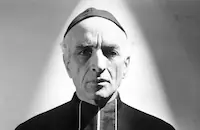Lady with Red Hair

Brief Synopsis
Cast & Crew
Kurt Bernhardt
Miriam Hopkins
Claude Rains
Richard Ainley
Laura Hope Crews
Helen Westley
Film Details
Technical Specs

Synopsis
In 1889, in Chicago, Mrs. Caroline Carter is victimized by her socialite husband's sensational divorce proceedings, and as a result, loses custody of her young son Dudley. Determined to acquire wealth and fame so that she can finance a legal battle to win back her son, Caroline goes to New York to become an actress. After renting a room in a theatrical boardinghouse owned by Mrs. Frazier, Caroline takes a letter of introduction to theatrical producer David Belasco who promises to write her a play in order to get rid of her. As the months pass, however, Caroline becomes impatient and stalks Belasco, impressing him with her fiery determination. Belasco works hard to make her an actress, but when the show flops, Caroline decides to marry Lou Payne, an actor from the boardinghouse who has fallen in love with her, and work in stock. The egostical Belasco, loath to admit failure, convinces her to postpone her marriage and rehearse for another play, which scores a year's run on Broadway. Returning to Chicago for a performance, Caroline realizes that her son is lost to her forever. After her European and American triumphs, Caroline tires of a life consumed by the theater and leaves Belasco to seek out and marry Payne. Infuriated, Belasco refuses to work with Caroline, who then determines to become a success on her own. After spending her fortune on a series of failed productions, Caroline loses her confidence and becomes convinced that she cannot act without Belasco. Payne persuades the producer to return to direct his former star,and when the play becomes a success, producer and actress are reunited.

Director

Kurt Bernhardt
Cast

Miriam Hopkins

Claude Rains

Richard Ainley

Laura Hope Crews

Helen Westley

John Litel

Mona Barrie

Victor Jory

Cecil Kellaway

Fritz Leiber
Johnnie Russell
Selmer Jackson

Cornel Wilde
Crew
Milo Anderson
Hugh Cummings
Arthur Edeson
Norbert Faulkner
Leo F. Forbstein
Bryan Foy
Oliver S. Garretson
James Gibbon
Edmund Grainger
Charles Kenyon
Milton Krims
Art Lueker
N. Brewster Morse
Max Parker
Lou Payne
H. Roemheld
Jack L. Warner
Perc Westmore

Photo Collections
Film Details
Technical Specs

Articles
The Lady With Red Hair
Though Mrs. Leslie Carter was very famous in her day, her contributions to the American stage are all but forgotten today. That makes it all the more interesting to learn the story of this fascinating actress known for her Titian red hair. Mrs. Leslie Carter, who used her married name professionally to spite her ex-husband, was from a school of "emotional" stage acting. This style had actors emoting with hysterical abandon, using wild behavioral mannerisms and gestures to visually convey internal feelings. Mrs. Carter's own style of acting was considered by her contemporaries to be an extreme version of this method.
Under the direction of David Belasco, Mrs. Carter enjoyed her greatest successes in plays like Zaza (1899), DuBarry (1902) and Adrea (1905). Belasco himself was known for his innovative contributions to the areas of stage lighting and design. His work showed how stage design and lighting could be manipulated to create an atmosphere depicting the emotional themes of the play. Unfortunately for Mrs. Carter, the partnership with David Belasco was shattered in 1906. Without telling Belasco, Mrs. Carter secretly eloped with fellow actor Louis Payne after a whirlwind romance. Belasco felt so betrayed that he cut himself off from her forever despite her numerous attempts over the years to contact him. Subsequently, her career suffered greatly without his guidance. As her lavish lifestyle enmeshed her in debt and her histrionic acting in second-rate plays became anachronistic, Mrs. Carter's career never regained its former glory.
For Miriam Hopkins, taking on the juicy role of Mrs. Carter in The Lady With Red Hair was a chance to breathe some life into her own fading film career. The role was a good fit for her, as many of her peers saw Hopkins' contentious temperament as not unlike that of Mrs. Carter. After top-notch work in films like Becky Sharp (1935) and These Three (1936), her roles had steadily dwindled. Eventually she was relegated to taking lesser parts, such as playing second fiddle to Bette Davis in The Old Maid (1939). Lady With Red Hair was a film that gave Hopkins a chance to shine on her own. Although the film didn't enjoy the success she had hoped, The Lady With Red Hair remains an excellent showcase for the often underrated actress.
Producer: Edmund Grainger, Jack L. Warner, Bryan Foy
Director: Curtis Bernhardt
Screenplay: Brewster Morse, Norbert Faulkner, Charles Kenyon, Milton Krims
Cinematography: Arthur Edeson
Film Editing: James Gibbon
Art Direction: Max Parker
Music: Heinz Roemheld
Cast: Miriam Hopkins (Mrs. Leslie Carter), Claude Rains (David Belasco), Richard Ainley (Lou Payne), Laura Hope Crews (Mrs. Dudley), Helen Westley (Mrs. Frazier), John Litel (Charles Bryant).
BW-79m.
by Andrea Passafiume

The Lady With Red Hair
Quotes
Trivia
Louis Payne, the husband of Mrs. Leslie Carter in real life, coached Richard Ainley, who was playing him in the movie.
Notes
The onscreen credits note that this film was based on the memoires of Mrs. Leslie Carter. According to a news item in Hollywood Reporter, Lou Payne, Caroline Carter's husband in real life, coached Richard Ainley in his role. Lady with Red Hair marked the motion picture debut of actor Cornel Wilde (1915-1989).
















